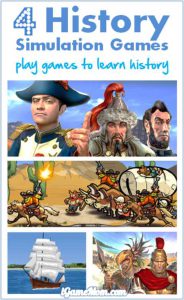 地理にあてはまることは,歴史に対してそれ以上に強くあてはまる。ただし,それは,初めのうちは,時間の感覚が十分発達していないので,もう少し大きくなってからのことである。
地理にあてはまることは,歴史に対してそれ以上に強くあてはまる。ただし,それは,初めのうちは,時間の感覚が十分発達していないので,もう少し大きくなってからのことである。
私見では,歴史は5歳ごろから始め,最初は,著名な人物の興味深い物語で,挿し絵がいっぱいついているものから始めるのが有益だと思われる。私自身も,5歳の時に,絵入りの英国史の本を一冊持っていた。マティルダ女王(Queen Matilda, 在位1162-1167.英国における初の女性君主で,スティーブン王との間で王位を争って闘った。)がアビンドン(Abindon)で氷のはったテムズ河を渡ったという話は,私にとても強い印象を与えたので,18歳のときに同じことを(私が)したときにも,やはりぞくぞくして,ステイーヴン王(King Stephen, 在位:1135年-1154/ )に追いかけられているような気がしたほどであった。5歳の男の子で,アレキサンダー大王の生涯に興味をもたない者は,ほとんどいないのではないだろうか。コロンブスは,もしかすると,歴史というよりは地理に属する人物かもしれないが,彼は満2歳の,少なくとも海を知っている子供にとっても興味があることは,私は証言できる(保証してもよい)。
子供が6歳になれば,世界史の梗概を学習する準備が十分できている(熟している)はずであり,その扱い方は,多少とも H.G. ウェルズ氏の歴史書の線に沿ったもので,必要な平易化を行い,写真をつけ,できれば映画を利用するとよい。子供がロンドンに住んでいる場合は,英国自然史博物館(Natural History Museum)で奇妙な動物を見ることができる。しかし,私なら,10歳かそこらで子供を大英博物館に連れていくことはしない。歴史を教える時には,子供が(興味を持つほど)成熟するまで,私たち(親たち)にだけ興味のあるような側面を押しつけないように注意しなければならない。
最初に子供の興味をそそる側面は,次の二つである。即ち,地質学から人類(の誕生)へ,野蛮人から文明人へなどといった、次々に展開される一般的な劇的場面とその進行(pageant and procession),それから(もう一つは),お気に入りの(共感を抱いている)英雄の登場する種々の事件についての劇的な物語りへの興味である。しかし,私たちは,野獣(だった祖先)から受け継いでいる野蛮性に絶え間なく妨げられながらも,知識を通して,私たち自身と私たちをとりまく環境を支配する方向へと次第に前進しつつある変化に富んだ進歩を徐々に遂げてきたのだという観念を,導きの糸として,肝に銘じておかなければならない。この観念は,外部の混沌と(人間の)内部の暗闇と闘い,理性のちっぽけな灯火が次第に成長して大きな明りとなり暗黒を追い払う,といった,全体としての人類の観念である。人種や国家や教義の間で区別を行うことは,私たちの唯一の人間的な活動とも言うべき(ミルトン『失楽園』の)「混沌(王)と暗闇(王)(Chaos and Old Night)」との闘いから私たちの心を逸らしてしまう愚行であるとして取り扱わなければならない。
What applies to geography applies even more strongly to history, though at a slightly more advanced age, because the sense of time is rudimentary at first. I think history can profitably be begun at about five years old, at first with interesting stories of eminent men, abundantly illustrated. I myself had, at that age, a picture-history of England. Queen Matilda crossing the Thames at Abingdon on the ice made such a profound impression upon me that I still felt thrilled when I did the same thing at the age of eighteen, and quite imagined that King Stephen was after me. I believe hardly any boy of five years old would fail to be interested by the life of Alexander. Columbus, perhaps, belongs more to geography than to history ; I can testify that he becomes interesting at the age of two, at least to children who know the sea. By the time a child is six years old he ought to be ripe for an outline of world-history, treated more or less on Mr. Wells’s lines, with the necessary simplifications, and with pictures, or the cinema if possible. If he lives in London he can see the strange beasts in the Natural History Museum ; but I should not take him to the British Museum before the age of ten or thereabouts. It is necessary to be careful, in teaching history, not to obtrude aspects which are interesting to us until the child is ripe for them. The two aspects which are first interesting are : the general pageant and procession, from geology to man, from savage man to civilized man, and so on ; and the dramatic story-telling interest of incidents which have a sympathetic hero. But I think we should keep in our own minds, as a guiding thread, the conception of gradual chequered progress, perpetually hampered by the savagery which we inherit from the brutes, and yet gradually leading on towards mastery of ourselves and our environment through knowledge. The conception is that of the human race as a whole, fighting against chaos without and darkness within, the little tiny lamp of reason growing gradually into a great light by which the night is dispelled. The divisions between races, nations, and creeds should be treated as follies, distracting us in the battle against Chaos and Old Night, which is our one truly human activity.
出典: On Education, especially in early childhood, 1926, Pt. 2:Education of character, chap. 15: The school curriculum before fourteen
詳細情報:http://russell-j.com/beginner/OE15-040.HTM
<寸言>
地理と異なり、歴史の学習には「時間の感覚」が必要。だから、「時間の感覚」が育っていない時に、歴史的事実を幼い子供にたくさん教えても効果が少ない。
「時間の感覚」が芽生えてきたら、少しずつ歴史上の事件や人物について、興味深い話をしてあげれば、多くの子供が歴史に興味を持つようになるはず。
中学以降の学校教育によって歴史の学習が楽しくなくなる可能性が出てくるのは、地理の学習と同じ理由。
